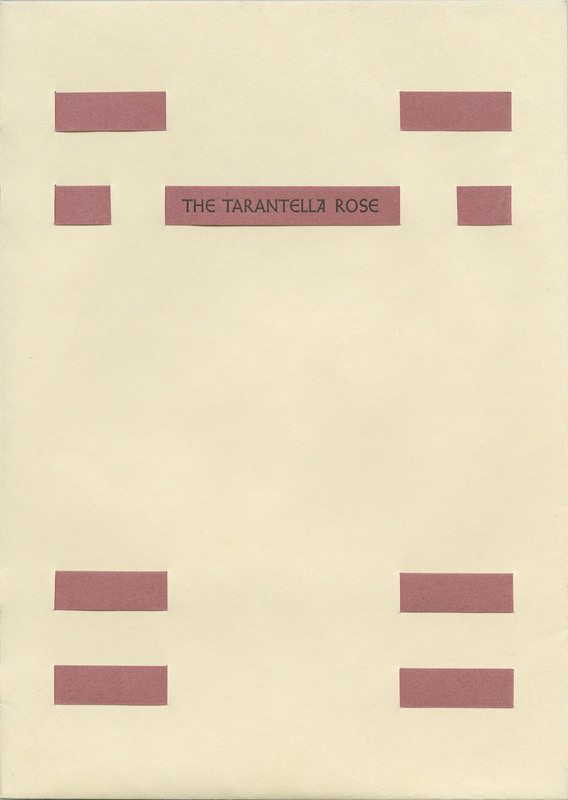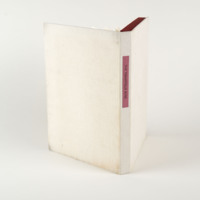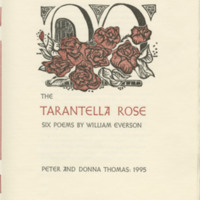A82. The Tarantella Rose
A82. William Everson. The Tarantella Rose. Santa Cruz, California: Peter & Donna Thomas, 1995.
27 x 19 cm (10 5/8” x 7 5/8”), 15 pages, 82 copies.
Binding: Modified limp vellum binding using paper handmade by Peter Thomas. Printed pages are sewn onto paper laces that are threaded into slits in the covers. Title on label on cover. Housed in a clamshell box covered in cream and red cloth. Title on label on spine. Copies A-G are quarter-bound in red Morocco leather and red paper handmade by Peter Thomas. Three-dimensional paper rose, folded by origami artist Chris Palmer, on cover. Paper: Cream, handmade with flax by Peter Thomas. Printing: Letterpress; quarto format. Typography: Text is Intertype Weiss. Titles are hand set Weiss Titling, Series II. Illustration: Seven linocuts by Donna Thomas. Illustrations hand-colored in copies A-G. Notes: Set at Anchor & Acorn Press.
“William Everson wrote these six poems in 1972-4 for his collected works, to create a literary bridge from the mood of his 1962 poem, ‘The Rose of Solitude,’ to his 1964 eulogy, ‘The Poet is Dead.’ I worked with Everson in 1976 when he started to print those poems, as part of a larger work he titled Eros and Thanatos, at the University of California, Santa Cruz’s Lime Kiln Press where he taught a course in fine printing. Due to overwhelming problems at the press the project was abandoned, the printed pages deposited in University of California Santa Cruz’s Special Collections Library, and the manuscript in the Bancroft Library at UC Berkeley.
When Everson's poems from this period were finally to be collected and printed as The Veritable Years, the later chronology of those six poems presented an overwhelming editorial dilemma and they were left out of the book. As a result they remained unknown and unpublished.
In 1989, after Donna and I had finished the printing of Everson’s poem, ‘The Poet is Dead,’ he suggested we print a book with the six unpublished poems he had written for Eros and Thanatos. Everson’s vitality was declining as his Parkinson’s disease advanced and this book became an extended reason for us to visit with him. Every time I had a new proof I would make a trip out to Everson’s remote Swanton Road home to show it, and discuss how to move forward. Tom Killion had illustrated our edition of ‘The Poet is Dead,’ but we decided Donna would illustrate this book. She took the challenge seriously, studying the poems in depth, visiting St. Alban’s, in Berkeley, to see the physical geography that had informed the poems, and lavishing attention on the design and her cutting of the blocks for those illustrations.
During the visits Everson would read the poems out loud, but the side effects of his Parkinson’s, and the drugs he took to combat it, often made it difficult for him to speak and be understood. The first time I brought proofs of Donna’s illustrations to show Everson he was having a bad day and he was shaking fairly uncontrollably, but as usual read the poems out. Afterwards, staring at the proofs he said, ‘Wrong cuts! Wrong cuts.’
Donna was devastated, and ready for us to abandon the project. I continued to plod ahead, printing a proof page of the first poem with the cut in place. A couple of weeks later I took it out to Swanton Road to show Everson. He was much better this time, less effected by the Parkinson’s side effects, and after reading the poem from the proof he said to me, just as he had the week before, ‘Strong cuts. Very strong cuts!’ He said they stood up well to the poems and the typeface, and was very pleased with the progress. He never saw more than those proofs. He died just months before we completed the printing binding.”


